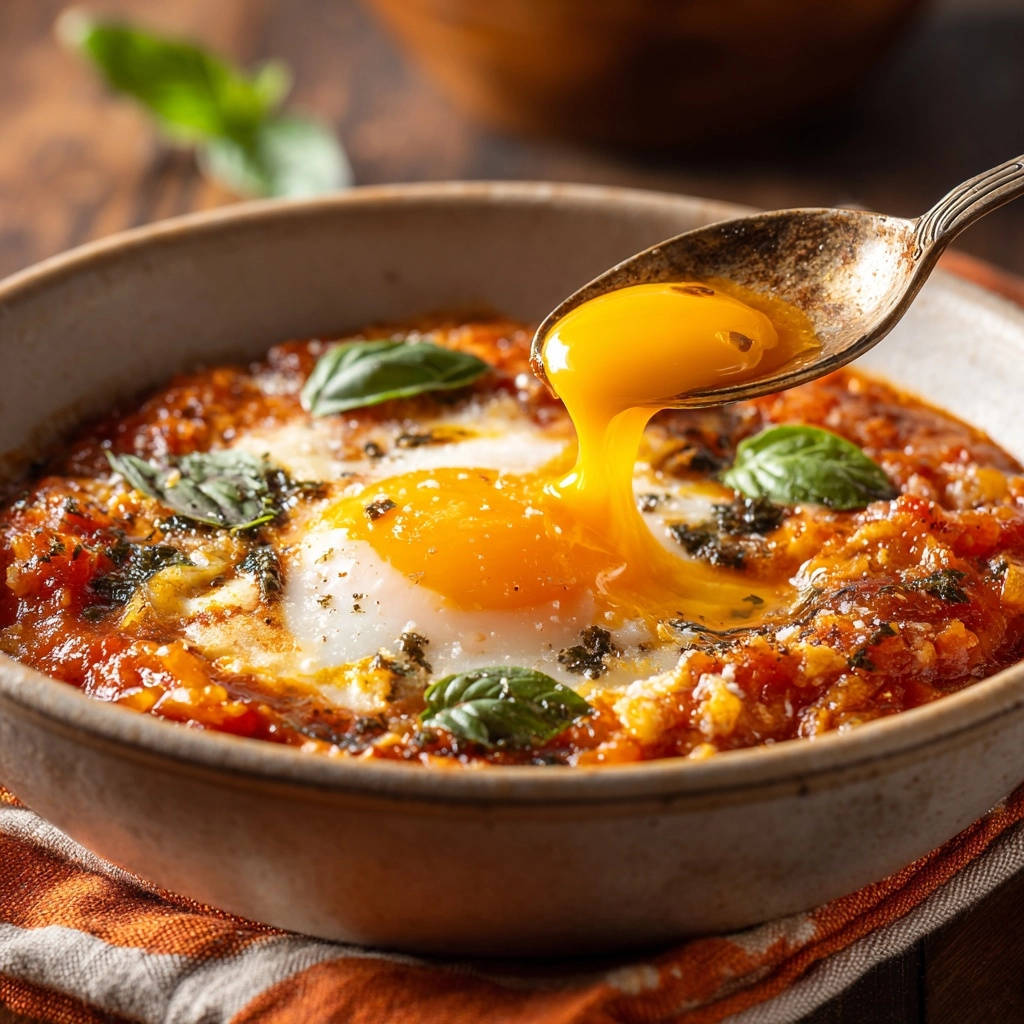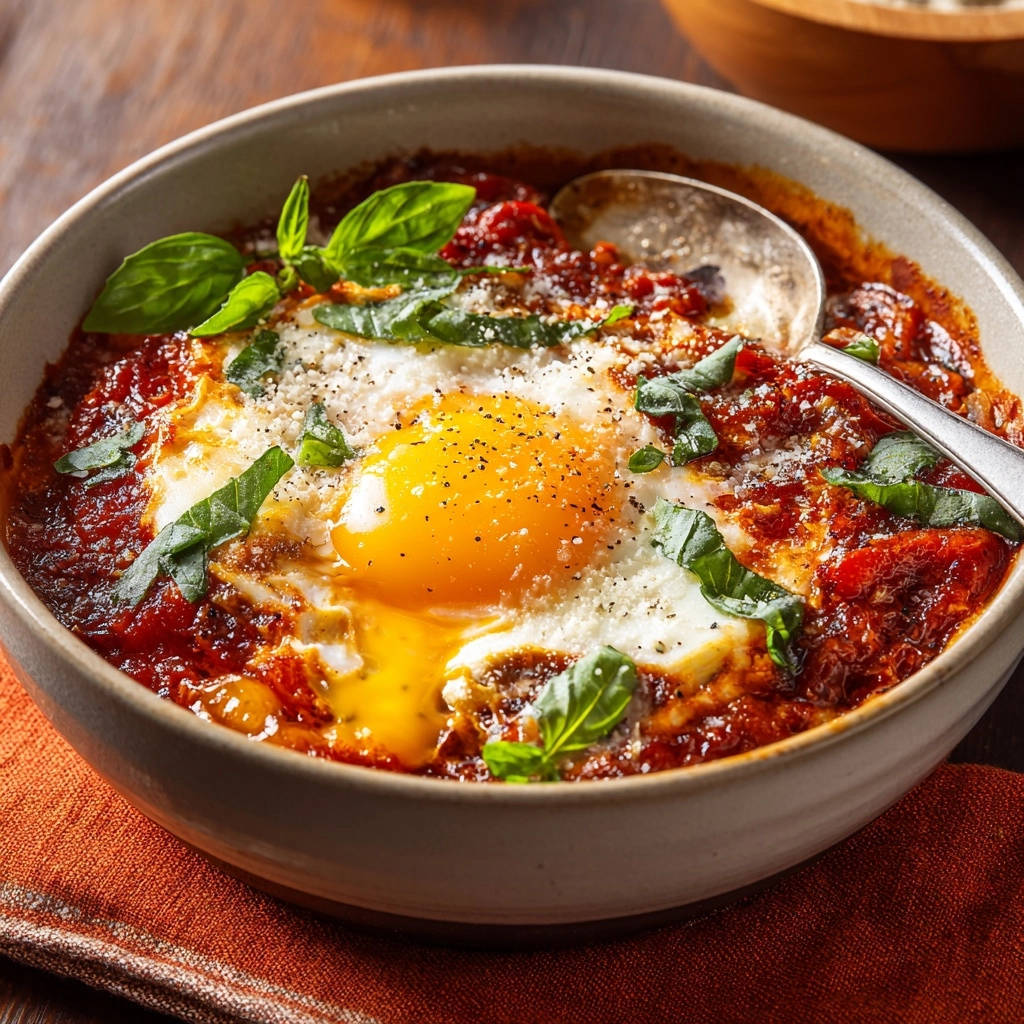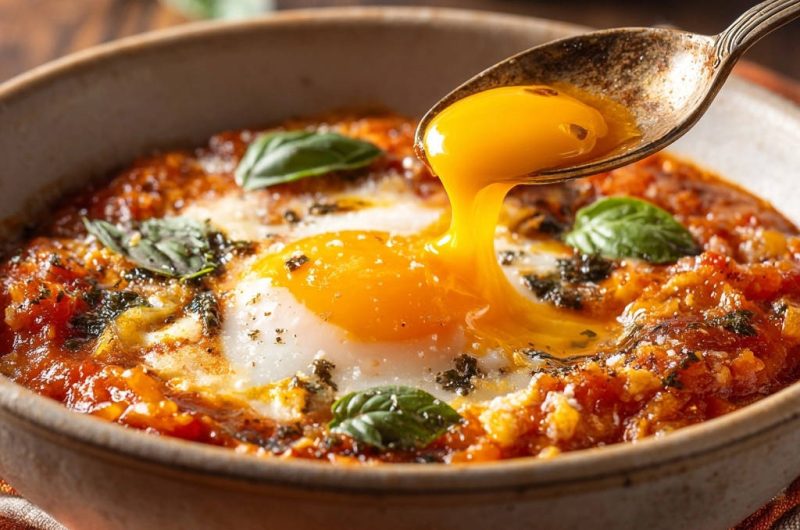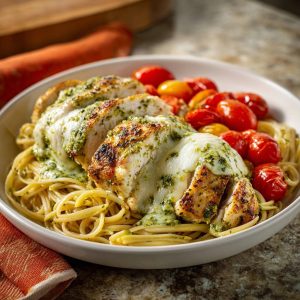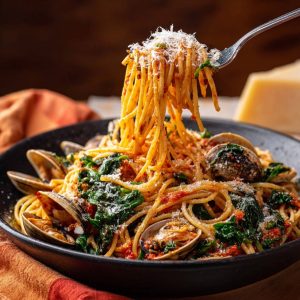For years, my quest for the perfect, runny yolk baked eggs was plagued by rubbery whites or slimy spots-a common frustration when attempting this classic dish.
I finally cracked the code using a simple heat transfer technique, and this recipe for Single-Serve Baked Eggs in Tomato Sauce guarantees a flawless texture every time.
It’s the ultimate 17-minute comfort meal, perfect for solo dining and maximizing that liquid gold yolk.
Why This Single-Serve Baked Eggs Recipe Solves Breakfast Chaos
This method focuses on efficiency and precision, turning a complex brunch staple into a reliable weeknight meal.
We eliminate common pitfalls like uneven cooking and overcooked yolks by mastering one crucial step that locks in the texture.
Precision Portion Control: No Waste, Just Deliciousness
This recipe eliminates the guesswork of cooking for one. It uses the exact quantity of sauce and one egg, ensuring perfect ratios and zero food waste.
The single-serve format also means faster heating and cooling, which contributes directly to the success of the precise baking window.
The Secret to Success: Eliminating Rubbery Whites
Standard baked eggs often result in uneven cooking because the cold sauce base takes too long to heat up, causing the delicate yolk to overcook before the egg white sets.
The key differentiator here is the transfer of hot, simmering sauce directly into the baking vessel.
By utilizing this pre-heated base, the egg white begins to cook instantly from below, setting the foundation for that ideal contrast: firm white and silky runny yolk.
Speed and Simplicity: Ready in Under 20 Minutes
From chopping the onion to garnishing the basil, the total time clocks in at under 20 minutes.
The rapid 5-minute sauce simmer followed by a quick bake (7-10 minutes) makes this a powerhouse meal ideal for rushed mornings or quick, satisfying lunches.
Flavor Foundation: Deconstructing the Simple Ingredients
The beauty of the Single-Serve Baked Eggs in Tomato Sauce lies in leveraging a few high-impact ingredients to build depth quickly.
The Aromatic Base: Onion, Garlic, and Olive Oil
Sweating the diced onion in olive oil slowly until translucent, rather than browning it, provides a sweet, soft foundation for the sauce.
After the onion softens, adding minced garlic and dried spices for just one minute-a process known as blooming-releases their essential oils and intensifies their flavor dramatically.
Crushed Tomatoes vs. Marinara: Choosing Your Sauce Texture
Canned crushed tomatoes lend a rustic texture and full tomato flavor, which is excellent for soaking up bread.
If time is exceptionally tight, a high-quality chunky marinara sauce can be substituted for an even faster prep.
The small addition of water or stock is essential to achieving the perfect simmering consistency needed to cradle the egg and ensure even heat transfer.
The Spice Blend: Italian Seasoning and Red Pepper Flakes
Dried Italian seasoning is the backbone of the flavor profile, providing classic herbaceous notes and depth.
Red pepper flakes are optional but highly recommended to introduce a subtle warmth that cuts through the richness of the yolk.
The Finishing Touch: Parmesan and Fresh Basil
Shredded Parmesan cheese adds a necessary layer of salty, umami richness that slightly browns during the bake, creating a delectable crust.
Fresh basil is non-negotiable; its bright, peppery aroma lifts the entire dish and adds a final burst of freshness when served hot.
Essential Tools for Precision Single-Serve Baked Eggs
You need very little equipment to execute this recipe, but the dimensions of your baking vessel are critical to success.
Selecting the Right Ramekin or Serving Bowl
The size of your baking vessel is crucial for achieving the correct bake time. We recommend an oven-safe ramekin or small bowl with a 1.5 to 2-cup capacity.
If the bowl is too shallow, the sauce will dry out quickly. If it is too large, the egg will spread too thinly, baking faster and potentially resulting in a solid yolk.
The Dedicated Skillet for Simmering
Cooking the sauce in a separate, small skillet first is integral to our ‘perfect yolk technique.’
This ensures the sauce reaches a rapid, steaming hot temperature before it is transferred, guaranteeing the immediate setting of the egg whites upon contact.
Mastering the Technique: Your Path to Perfect Single-Serve Baked Eggs in Tomato Sauce
- Preheat and Prepare Your Vessel:
- Sauté the Aromatics and Bloom the Spices:
- Building and Thickening the Tomato Sauce:
- THE CRITICAL HEAT TRANSFER: Guaranteeing the Perfect Yolk Technique
- Cracking and Seasoning the Egg:
- Monitoring the Bake Time: The Jiggle Test
- Serving Immediately: The Finishing Garnish
Set your oven to 375 degrees F and place your small, 1.5 to 2-cup capacity oven-safe ramekin nearby.
Starting with a fully preheated oven is essential for accurate, consistent cooking time.
Heat the olive oil in a small skillet. Cook the diced onion until it is completely soft (about 3 minutes), ensuring it never browns or crisps.
Stir in the minced garlic, Italian seasoning, and red pepper flakes, cooking only until fragrant, about 60 seconds, to release the spice oils.
Stir in the crushed tomatoes, water or stock, and season lightly with salt and pepper. Bring the mixture to a low, steady simmer and let it bubble gently for exactly 5 minutes.
This dedicated simmering time allows the excess moisture to evaporate, resulting in a thick, stable sauce base that will prevent the egg from sinking or the final dish from being watery.
Immediately and carefully pour the entire contents of the hot, simmering tomato sauce directly into your prepared ramekin. The sauce must be visibly steaming when transferred.
This step is non-negotiable: the hot base rapidly begins cooking the bottom layer of the egg white upon contact.
This crucial head start guarantees the whites will be completely opaque and set without turning your delicate yolk rubbery during the short bake time.
Gently crack the large egg directly into the very center of the hot sauce. It should settle nicely without touching the sides of the dish.
Finish the dish by sprinkling the egg and sauce lightly with salt, pepper, and the tablespoon of parmesan cheese.
Immediately place the bowl in the preheated 375 degree F oven and bake for 7 to 10 minutes. The difference between runny and solid is often only one minute, so start checking at the 7-minute mark.
The Single-Serve Baked Eggs in Tomato Sauce are perfectly done when the white surrounding the yolk is completely opaque and firm to the touch, but the yolk still visibly jiggles when you carefully nudge the bowl.
Carefully remove the piping hot bowl using oven mitts. Garnish generously with fresh basil leaves.
Serve immediately with crusty toast or bread so your guests can dip directly into that beautiful, rich tomato sauce and glorious runny yolk.
Troubleshooting Baked Eggs: Achieving the Ideal Runny Yolk Texture
Help! My Egg Whites are Still Slimy
The primary cause is usually insufficient heat. Ensure your sauce was truly boiling hot when you poured it into the ramekin for the critical heat transfer step.
Verify your oven is properly calibrated, and try baking for one additional minute next time, ensuring the white closest to the yolk is fully opaque.
My Yolk is Solid and Rubber-Like
You have overbaked the dish. Check the eggs exactly at the 7-minute mark, not later, and pull them the moment the white is set.
If this persists, reduce your oven temperature slightly (perhaps to 350°F) or consider pulling the eggs out of the oven when the yolk is just starting to haze over, as residual heat will continue cooking it.
The Sauce Dried Out During Baking
This suggests your initial sauce was too thick or your ramekin was too shallow, exposing too much surface area to the oven’s heat.
Ensure you used the required water or stock during the simmering phase to create a less dense consistency. If using a shallower dish, try reducing the bake time to 8 minutes total.
Beyond Basic: Flavor Swaps and Customizations for Your Meal
Boosting the Flavor: Adding Vegetables and Greens
-
Spinach or Kale: Stir a handful of fresh spinach or finely shredded kale into the tomato sauce during Step 3 (the 5-minute simmer). The greens will wilt down perfectly into the sauce base.
-
Mushrooms or Bell Peppers: Diced vegetables must be sautéed separately with the onion in Step 2 until fully softened. Raw vegetables will not cook sufficiently during the short bake time.
Cheese Alternatives for Different Textures
-
Feta: Substitute parmesan with 1 tablespoon of crumbled feta for a salty, tangy bite that softens into the sauce beautifully.
-
Goat Cheese: A small dollop of soft goat cheese provides intense tang and creaminess; add it just before baking instead of or alongside the parmesan.
-
Mozzarella: Shredded low-moisture mozzarella adds a stretch factor. Use sparingly, as too much cheese will impede the even baking of the egg white.
Making it a Hearty Dinner: Protein Add-Ins
To transform this into a substantial dinner, stir 1/4 cup of pre-cooked protein into the sauce during the simmering step.
Fully cooked ground Italian sausage or seasoned crispy bacon crumbles work exceptionally well. Since the protein is pre-cooked, it will not affect the overall 7-10 minute baking window.
Perfect Pairings and Serving Suggestions
Choosing the Best Bread for Dipping
The best pairing for this dish relies on a crusty, sturdy bread capable of scooping up the rich tomato sauce and the runny yolk.
Opt for thinly sliced sourdough, a fresh baguette, or toasted pita points. Avoid soft sandwich bread, which will quickly turn soggy in the sauce.
Side Dishes to Complete the Meal
For a light lunch pairing, serve the baked eggs alongside a simple, peppery arugula salad dressed lightly with lemon and olive oil.
In the evening, a side of roasted, crispy breakfast potatoes or sliced avocado adds healthy fats and complexity to the plate.
Make-Ahead and Storage Tips for Single-Serve Convenience
Can I Prepare the Sauce Base Ahead of Time?
Yes, the spiced tomato sauce base can be made up to three days in advance and stored in the refrigerator.
If storing, you must reheat the sauce until steaming hot immediately before transferring it to the ramekin and adding the egg. Do not try to bake the egg in cold sauce.
Reheating Baked Eggs in Tomato Sauce
While this dish is always best enjoyed fresh, leftovers can be gently reheated.
To maintain the most appealing texture, cover the ramekin lightly with foil and bake at 300°F until warmed through.
Note that the yolk will likely set completely during reheating, but the flavor of the baked eggs remains excellent.
Quick Questions About Single-Serve Baked Eggs in Tomato Sauce
Can I double or triple this recipe?
You should definitely use separate vessels if scaling up this recipe. The precise bake time relies on the even heat distribution in the small 1.5-cup ramekin.
Baking multiple eggs in one large dish will dramatically alter the required cooking time, risking an uneven, undercooked center and compromising the perfect yolk technique.
Is this recipe suitable for lunch or dinner?
Absolutely. While perfect for a quick breakfast, the rich flavor profile and customizable nature of this recipe make it ideal for a light lunch or even a satisfying weeknight dinner.
Simply add a heartier side like crusty bread, cheese alternatives, or some cooked sausage to round out the meal.
How do I know when the sauce is the right thickness before baking?
After the 5-minute simmer, the sauce should be thick enough to lightly coat the back of a spoon, almost like a thin tomato soup.
This optimal consistency ensures the egg stays cradled in the center and prevents the white from mixing completely into the liquid base during baking.
Ready to Impress? Share Your Single-Serve Baked Eggs Masterpiece!
Stop settling for dry, tough baked eggs. This specific technique for Single-Serve Baked Eggs in Tomato Sauce simplifies the process while delivering maximum flavor and guaranteed results.
This recipe transforms 17 minutes into pure comfort. Grab your ramekin, toast your sourdough, and prepare to enjoy the perfect, dippable runny yolk you deserve.
Single-Serve Baked Eggs in Tomato Sauce
Course: BreakfastCuisine: Italian cuisineDifficulty: easy1
serving5
minutes12
minutes17
minutesItalian cuisine
Ingredients
1 tablespoon olive oil
1/4 cup diced onion
1 clove garlic, minced
1/2 teaspoon dried Italian seasoning
1/4 teaspoon red pepper flakes (optional)
1/2 cup canned crushed tomatoes (or chunky marinara sauce)
1 tablespoon water or chicken stock
1 large egg
1 tablespoon shredded parmesan cheese
Salt and black pepper to taste
Fresh basil leaves, for garnish
Directions
- Preheat the oven to 375 degrees F. Find a small, oven-safe serving bowl or ramekin (about 1.5 to 2 cup capacity).
- Prepare the sauce base. In a small skillet or saucepan, heat the olive oil over medium heat. Add the diced onion and cook until softened, about 3 minutes. Add the minced garlic, Italian seasoning, and red pepper flakes (if using). Cook for 1 minute until fragrant.
- Add the crushed tomatoes, water or stock, and season lightly with salt and pepper. Bring the sauce to a gentle simmer. Reduce heat and let it bubble slowly for 5 minutes, allowing it to thicken slightly.
- THE PERFECT YOLK TECHNIQUE: Pour the hot, simmering tomato sauce directly into the oven-safe serving bowl. It is crucial that the sauce is already hot and steaming. This pre-heated base rapidly starts cooking the egg white from below, guaranteeing even cooking.
- Using caution, crack the egg directly into the center of the hot sauce. Sprinkle the entire dish with a pinch of salt, pepper, and the parmesan cheese.
- Immediately place the bowl in the preheated 375 degree F oven. Bake for 7 to 10 minutes. Begin checking the egg at the 7 minute mark.
- The egg is perfectly done when the egg white is completely opaque and set, but the yolk still jiggles visibly when you gently tap the bowl.
- Carefully remove the bowl from the oven. Garnish immediately with fresh basil leaves. Serve hot with toast for dipping into that beautiful, runny yolk.

